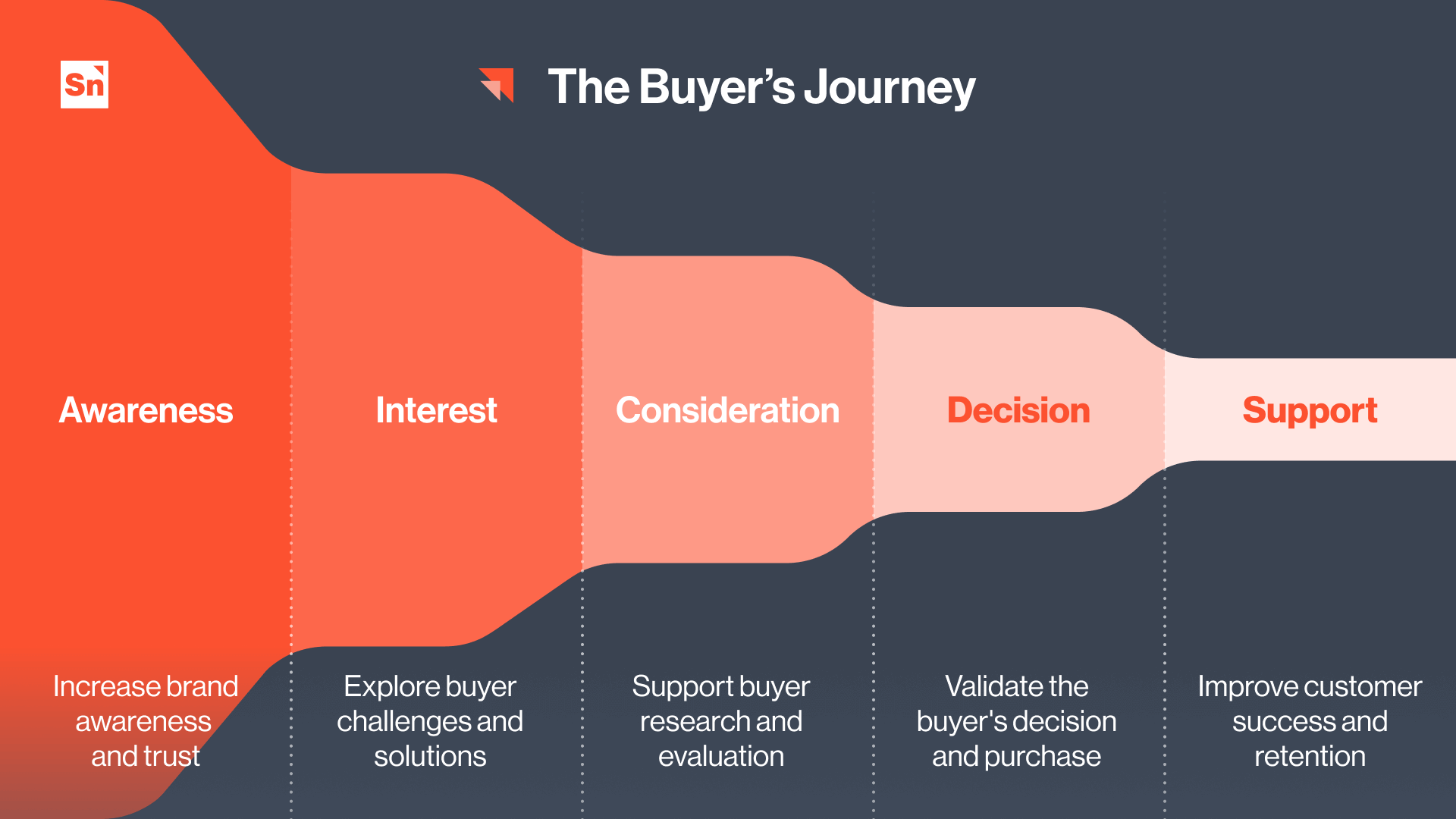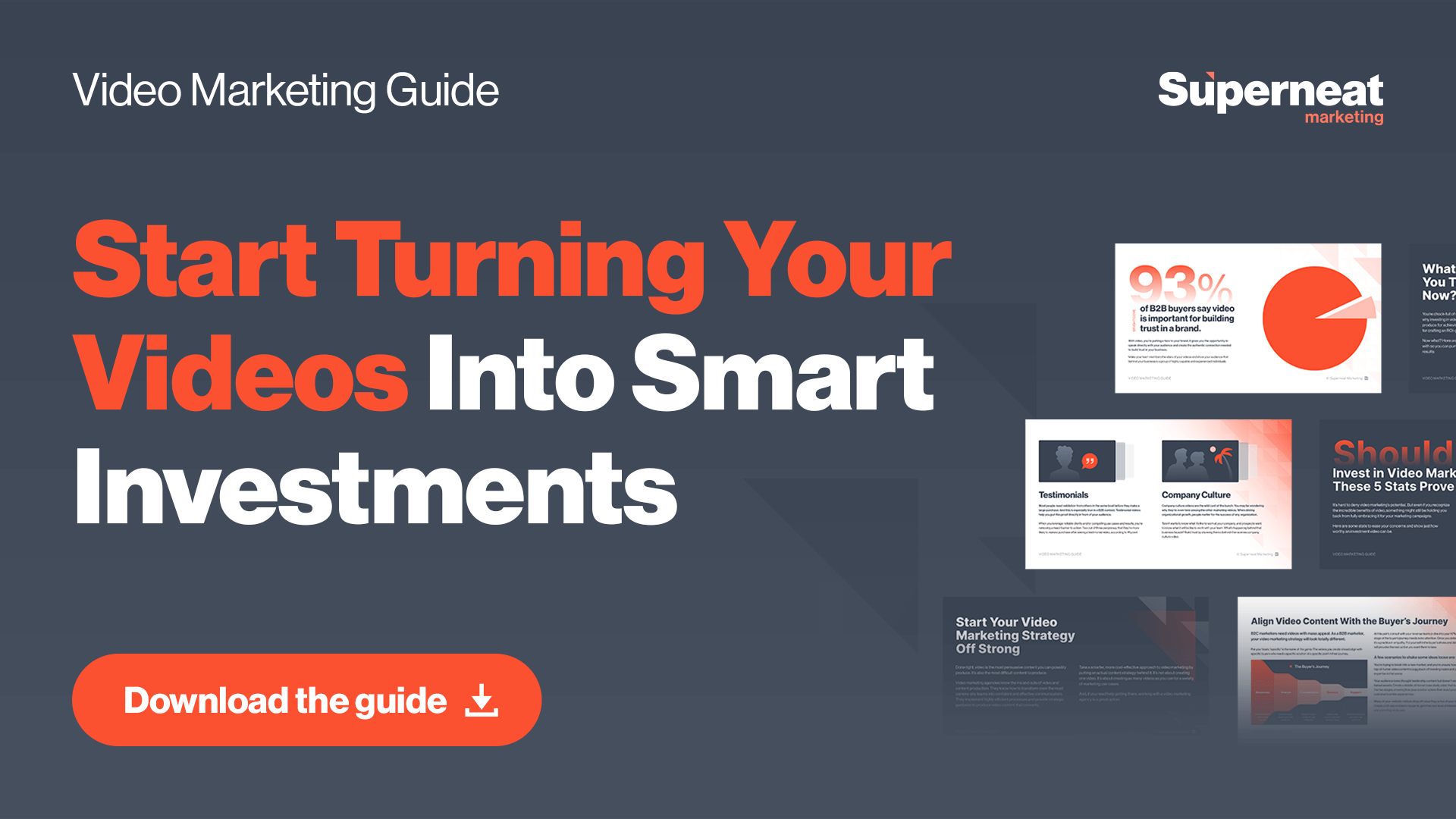It’s easy to blow your marketing budget on a single video. Video’s expensive, but it’s oh-so-alluring. So you go all in. You spend $10,000 on one video and hope for the best.
As you watch it tank on all of your marketing channels, you do an incredible disappearing act—channeling the “Homer Simpson backs into the bushes” GIF.
Or instead, you can take a smarter, more cost-effective approach to video marketing by putting an actual content strategy behind it. It’s not about creating one video. It’s about creating as many videos as you can for a variety of marketing use cases.
Align Video Content With the Buyer’s Journey
“Specific” is the name of the game as a B2B marketer. Unlike B2C marketing, you’re not on a mission to create videos with mass appeal. The videos you create should align with specific buyers who need a specific solution at a specific point in their journey.
Here are your video goals for each of these buyer stages:

- Help your potential buyer understand their problem. (Awareness)
- Help your potential buyer understand their problem and find a solution. (Interest)
- Help your potential buyer solve their problem. (Consideration)
- Help your buyer validate their purchase decision. (Decision)
- Help your customers feel supported and successful. (Support)
At this point, consult with your revenue team or dive into your KPIs to determine which stage of the buyer’s journey needs extra attention. Once you determine where to focus, it’s a practice in empathy. Put yourself in the buyer’s shoes and determine what content will provoke the next action you want them to take.
Don’t Record Anything Without a Content Strategy
When building your content strategy for a live shoot, you’re thinking about your marketing objectives on a deeper level. Because this is high-production video content, these videos will live permanently on your website and be shared on multiple marketing channels.
Make a list of all of the important marketing initiatives that could pack a bigger punch with video. Then, work backward from these video deliverables and figure out the:
- Goal – What is the call to action, and how does it align with existing marketing objectives?
- Talent – Which leadership and team members will communicate this important message effectively?
- Message – Which prompts—questions or talking points—will ensure you get the desired responses for the most impactful video content?
Videos filmed remotely are typically top-of-funnel (i.e. tutorials, thought leadership) and mid-funnel content (i.e. case studies).
These videos already align with the existing content strategy for the organization, with personas and buyer stages front and center. In a similar fashion to the live shoot, you’ll need to figure out the:
- Goal – What is the call to action, and how does it align with the existing content strategy?
- Talent – Which subject matter experts will speak confidently about the topic? Which customers will tell the best success story?
- Message – Which format—scripted or conversational—will ensure you get the right points across to your intended audience?
Make Every Video Shoot Count
A live shoot is a full-day extravaganza. It’s a golden opportunity to produce dozens of engaging videos by interviewing multiple people throughout the day.
In-Person Shoots
For live video production, the DP (Director of Photography) and additional video crew members are going to charge a day rate.
You might be thinking that you don’t need them for the entire day because you’re only planning to capture one video. That tunnel vision will get you into trouble, and you’ll end up with a $10K video that potentially flops.
So, definitely don’t hire an entire production crew and shoot one measly video. Capture as much footage as possible and shoot a ton of videos. To pull this off, you have to create a content strategy well in advance of your shoot.
Remote Shoots
Alternatively, a remote filming session is a jam-packed hour. Although short, you can still get more than one video out of a single recording session by producing a full-length video and cutting a few short edits during post-production.
With remote video production, an hour may seem like a long time, but it’s not. The first part of that recording session will be spent on framing, lighting, and sound to ensure production quality. If lots of time is needed for technical setup, you may only have a half hour to record.
All the more reason to have a solid content strategy in place beforehand.
Make Sure People Are Camera-Ready
The camera doesn’t lie. If someone isn’t prepared and decides to riff, it will show. If someone is nervous and sweating profusely, it will show.
Nothing will save your video if the shoot doesn’t go well with the on-camera talent. Unlike written content, where you can take as many liberties as you want, you only have so much power in post-production.
Even the best presenters in the world will freeze up when they’re locking eyes with a camera. It’s understandably difficult to address a lens or a screen and pretend like you’re speaking to a real person.
To get people camera-ready, make sure they feel completely prepared. This goes back to your content strategy and the supporting materials (script outline, questions, etc.) that need to be shared with on-camera talent ahead of time.
What they wear is also critically important, so share clothing guidelines as well. In general, on-camera talent should avoid any flashy colors, logos, or patterns. Pro tip: Thick stripes almost always look awful on camera.
It also helps to work with video marketing experts who know how to make people look and sound their best.
Share Videos Across Marketing Channels
Since video is a bigger investment than written content, you’ll want to make sure you’re getting as much mileage out of each video as possible with multi-channel content distribution.
Website
Heavy-hitting, solution-focused video content should be featured prominently to keep website visitors engaged on the page.
Blog
A blog post with an embedded video is a great way to improve your website’s performance and SEO rankings. Blogs that include videos generate more organic traffic and increase “time on page.” Articles with at least one video get about double the page views.
Content Platforms
In addition to your own blog, consider using external content platforms like LinkedIn Publishing or Medium to reshare video content with audiences beyond your website’s reach.
YouTube
You’ve heard of it…YouTube is the world’s leading platform for video content, so it’s a must for distribution. Posting quality content consistently will grow your audience over time—as long as you’re giving people something of value.
While it’s totally acceptable to sprinkle in some mid-funnel content, like customer success stories or solution-specific videos, YouTube audiences crave tutorials, podcasts, and thought leadership. They want to learn from others’ experiences.
You can approach your email CTA in a couple of different ways when it comes to video content. The link for the CTA can either go directly to the YouTube video or your website/blog page with the embedded video, depending on which channel you’re pushing.
Either way, add an eye-catching thumbnail or GIF so your email subscribers know there’s an exciting video they get to watch on the other side of that CTA button.
Landing Pages
77% say a testimonial video has played a part in convincing them to buy a product or service. Landing pages are prime real estate for a testimonial video, which helps increase conversions.
Social Media
Social media is very conducive to short-form video content, so you’ll want to create 2-3 short edits from any full-length video that is longer than three minutes.
That doesn’t mean you should entirely avoid sharing the full-length video on social media channels, though. Experiment with different length formats to see which your audience prefers. Keep in mind that each social channel has video limits. LinkedIn has a 10-minute maximum length for videos, for example.
Another important note: Rather than sharing YouTube links, be sure to upload and share videos directly on your social media channels. Social algorithms favor native videos because they keep people right where they want them—in their ecosystem. Videos will perform better if you share them natively.
Video is some of the most expensive content to produce, but it’s also the most effective way to communicate with your audience. Video is the next best thing to a human conversation. It can’t be beat.
Don’t wing it. The investment in video marketing is worth it, as long as you have a content strategy behind it.

